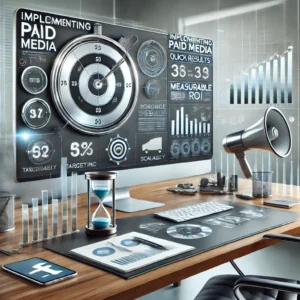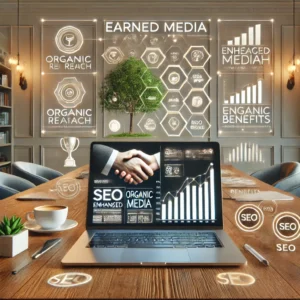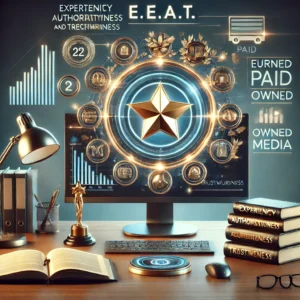Unlocking the Full Potential of Diverse Media Types for a Winning Marketing Strategy
In the dynamic landscape of public relations (PR) and media marketing, professionals are continuously evaluating the unique benefits of earned media in contrast to paid media. Each category of media is instrumental in crafting a well-rounded media strategy. As we approach 2025, the seamless integration of these media types—including owned and shared media—is essential for optimizing outreach, building trust, and fostering sustainable growth in any marketing campaign.
Enhancing Brand Visibility with Targeted Paid Media Strategies
Understanding Paid Media: Practical Applications and Illustrative Examples
Paid media encompasses all advertising initiatives that necessitate financial investment for placements. This approach is particularly effective as it provides a direct pathway to elevate your brand visibility and broaden your reach across various advertising platforms. Common forms of paid media include:
- Digital Ads: These involve banner ads, display ads, and video ads strategically placed on websites and applications to effectively capture audience attention.
- Fan Acquisition: Strategies designed to boost your follower count across different social media platforms.
- Boosted Content: Promoting existing content to increase its visibility and reach among a broader audience.
- Native Advertising: Ads crafted to blend seamlessly with the platform's organic content, ensuring a non-disruptive user experience.
- Content Syndication: Sharing your content across multiple third-party sites to maximize exposure and audience engagement.
- Sponsored Content: Partnering with publishers to create promotional articles or posts that effectively highlight your brand.
- Content Distribution: Guaranteeing that your content effectively reaches your target audience via paid channels.
- Pay to Play: Investing in media placements to enhance visibility across your preferred channels.
- Media Relations: Building relationships with media outlets to create paid opportunities for greater exposure.
- Influencer Marketing and Shout-Outs: Compensating influencers to promote your brand and connect with their followers.
- Experiential Marketing: Designing immersive experiences that your brand sponsors to attract potential customers.
- Marcomm: Encompassing a variety of marketing communications strategies that integrate paid media channels.
 Key Advantages of Incorporating Paid Media into Your Marketing Strategy
Key Advantages of Incorporating Paid Media into Your Marketing Strategy
Integrating paid media into your marketing efforts offers a multitude of advantages that are critical for modern strategies:
- Immediate Results: Unlike organic marketing strategies that require time to show results, paid media can provide instant visibility and significant traffic boosts almost immediately.
- Targeted Reach: Thanks to sophisticated targeting capabilities, you can connect with specific demographics, interests, and behaviors that closely align with your ideal audience.
- Scalability: Paid media campaigns can be easily adjusted to fit your budget and campaign goals, allowing for flexibility as needed.
- Measurable ROI: With the help of analytics tools, you can accurately track performance and return on investment, enabling you to assess the effectiveness of your campaigns.
- Control Over Messaging: Paid media provides direct control over the content and presentation of your advertisements, ensuring alignment with your brand values.
Implementing Proven Tactics for Enhanced Paid Media Outcomes
To maximize the benefits of paid media, consider employing the following impactful strategies:
- Utilize Programmatic Advertising: Automate your advertising purchases to effectively target specific audiences on a larger scale.
- Leverage Social Media Ads: Platforms like Facebook, Instagram, LinkedIn, and Twitter offer robust advertising options to effectively engage diverse audiences.
- Invest in Search Engine Marketing (SEM): Use Google Ads and similar search engine platforms to attract traffic driven by user intent and search behavior.
- Experiment with Video Advertising: Capture audience attention with compelling video content on platforms like YouTube and TikTok.
- Optimize for Mobile: Ensure your paid media campaigns are mobile-friendly, given that a significant portion of digital traffic now comes from mobile devices.
- A/B Testing: Regularly test different ad creatives, copy, and targeting strategies to maximize overall campaign performance.
- Retargeting Campaigns: Re-engage users who have previously interacted with your brand to improve conversion rates and enhance customer loyalty.
Understanding the Crucial Role of Earned Media in Modern Marketing
The Transformation of Earned Media: Definition and Significance
Earned media refers to the publicity and visibility gained through non-paid efforts, encompassing all organic coverage received by your brand. This form of media significantly enhances your credibility and authority within your industry. Historically, earned media focused on obtaining mentions in journalistic outlets and blogs. However, since 2024, the landscape has evolved to include a wide array of digital interactions, expanding the definition and scope of earned media.
 Key Benefits of Earned Media for Your Brand
Key Benefits of Earned Media for Your Brand
The benefits of earned media are considerable, particularly in fostering long-term trust and establishing authority:
- Credibility and Trust: Earned media is often seen as more reliable since it is not directly funded, thereby enhancing consumer trust in your brand.
- Organic Reach: This type of media can facilitate viral sharing, enabling organic growth without continuous financial investments.
- SEO Benefits: Obtaining high-quality backlinks from reputable sources can significantly boost your website's search engine rankings and overall visibility.
- Long-Lasting Impact: The effects of earned media can endure well beyond the initial coverage, offering ongoing benefits for your brand.
- Enhanced Brand Reputation: Positive reviews and word-of-mouth referrals can significantly improve your brand's image among consumers.
Strategies for Effectively Leveraging Earned Media Advantages
To successfully harness the potential of earned media, consider implementing these effective strategies:
- Public Relations (PR): Develop strong relationships with journalists and media outlets to secure valuable coverage for your brand.
- Content Marketing: Create high-quality, shareable content that attracts mentions and links from other authoritative sources.
- Influencer Relations: Work with key influencers who can authentically promote your brand to their followers.
- Social Media Engagement: Actively engage in discussions on platforms like Twitter (now X) and Reddit to boost your brand's visibility.
- Encourage Reviews and Testimonials: Promote positive user reviews on platforms like Yelp, Google Reviews, and industry-specific sites.
- Referral Programs: Create structured programs to incentivize existing customers to refer new clients to your business.
- Link Building: Employ strategies to earn high-quality backlinks from authoritative websites to improve your SEO.
- Participate in Industry Events: Increase visibility by sponsoring or contributing to relevant industry events and webinars.
Maximizing Marketing Potential Through Owned and Shared Media
The Integral Role of Owned Media in Your Marketing Framework
Owned media encompasses the marketing channels that your brand controls, including your website, blog, email newsletters, and social media profiles. These platforms are essential for establishing a consistent brand voice and delivering valuable content to your audience.
Core Elements of Owned Media:
- Website: Serving as the central hub for your digital activities, your website should offer comprehensive information about your products or services.
- Blog: A platform for sharing insights, updates, and valuable content designed to attract and engage your target audience.
- Email Marketing: Facilitates direct communication with your audience, fostering lead nurturing and relationship building.
- Social Media Channels: Platforms where you can interact with your audience, share content, and effectively promote your brand.
Effective Strategies for Leveraging Shared Media
Shared media includes content that is distributed across social networks and other platforms, often created by users or fans. This comprises user-generated content (UGC), shares, likes, and comments that organically extend your brand's reach.
Effective Approaches for Shared Media:
- Encourage UGC: Motivate your audience to create and share content related to your brand through engaging contests and campaigns.
- Foster Community Engagement: Build a strong community by actively interacting with your audience across social media platforms.
- Utilize Social Sharing Tools: Integrate social sharing buttons on your website and blog to make it easy for users to share content.
- Collaborate with Influencers: Partner with influencers to extend your reach through their established audiences.
- Monitor and Respond: Keep track of shared mentions and respond promptly to maintain a positive brand image and engagement.
 Grasping the Significance of E.E.A.T. in Your Media Strategy
Grasping the Significance of E.E.A.T. in Your Media Strategy
Understanding E.E.A.T. and Its Relevance in Marketing
E.E.A.T. stands for Expertise, Authoritativeness, and Trustworthiness. This principle is crucial in the realms of SEO and digital marketing, as it significantly influences how search engines evaluate and rank your content. Establishing a strong E.E.A.T. profile can considerably enhance your online visibility and strengthen credibility with consumers.
Enhancing E.E.A.T. Through Integrated Media Strategies
By harmonizing earned, paid, owned, and shared media, you can significantly enhance your E.E.A.T. through the following methods:
- Showcasing Expertise: Leverage your owned media platforms to publish high-quality, informative content that highlights your knowledge and skills.
- Building Authoritativeness: Earned media coverage from reputable outlets and endorsements from influencers can position your brand as a leader in its field.
- Fostering Trustworthiness: Consistent and transparent communication across all media types helps cultivate trust with your audience and stakeholders.
- Generating Backlinks: Efforts in earned media, such as PR outreach and collaborations with influencers, can yield valuable backlinks that enhance your site's SEO.
- Engaging with Your Audience: Active engagement through shared media, including responding to comments and discussions, boosts your brand's trustworthiness and reliability.
Crafting a Comprehensive Media Strategy that Integrates All Four Media Types
Effective Strategies for a Cohesive Media Approach
To fully harness the potential of your media initiatives, it is crucial to integrate earned, paid, owned, and shared media into a cohesive strategy. Here are practical ways to achieve this:
- Define Clear Objectives: Determine what you aim to accomplish with each media type, whether it is increasing reach, enhancing credibility, or driving conversions.
- Align Content Across Channels: To establish a unified brand presence, ensure consistency in your messaging and branding across all media platforms.
- Leverage Synergies: Use paid media to amplify your earned media efforts, such as promoting positive PR stories through digital advertising.
- Monitor and Analyze Performance: Employ analytics tools to evaluate the effectiveness of each media type and adjust your strategy based on insights gathered.
- Adapt to Trends: Stay informed about the latest media trends and technologies to keep your strategy relevant, competitive, and effective.
Case Studies Demonstrating Success Through Media Integration
Case Study 1: Tech Innovators Inc.
Tech Innovators Inc. effectively merged earned and paid media by launching an innovative product. They employed paid digital ads to generate buzz and direct traffic to their website. Simultaneously, they engaged in PR efforts to secure features in leading tech publications, significantly boosting their credibility. By leveraging social media sharing and influencer collaborations, they achieved a viral effect that greatly enhanced their brand authority and sales.
Case Study 2: EcoFriendly Solutions
EcoFriendly Solutions educated its audience on sustainability topics by blending content marketing (owned media) with sponsored content (paid media). Their earned media efforts, such as securing features in environmental blogs and actively participating in industry forums, positioned them as leaders in their niche. Integrating shared media through user-generated content campaigns further amplified their messaging, cultivating customer trust and loyalty.
 Emerging Trends Influencing the Future of Media Marketing in 2025
Emerging Trends Influencing the Future of Media Marketing in 2025
As we advance through 2025, several key trends are shaping the future of media marketing:
- AI-Driven Personalization: Utilizing artificial intelligence to create highly tailored advertising and content experiences based on individual preferences and behaviors.
- Interactive Content: Boosting engagement by incorporating interactive features such as polls, quizzes, and augmented reality experiences to captivate your audience.
- Video Dominance: The rise of video content continues, with a strong emphasis on short-form and live-streaming formats across various platforms.
- Sustainability and Social Responsibility: Brands are increasingly committing to social and environmental causes to foster consumer trust and loyalty.
- Voice Search Optimization: Adapting content strategies to capture a growing segment of search traffic from voice-activated devices.
- Privacy and Data Security: Navigating the complexities of increasing regulations and consumer concerns regarding data privacy in media strategies.
- Hybrid Events: Combining in-person and virtual elements to create inclusive and scalable event experiences that cater to diverse audiences.
Common Questions About Media Strategies
1. How does earned media differ from paid media?
Earned media refers to organic publicity gained through PR, word-of-mouth, and influencer mentions, while paid media involves financial investments for advertising placements aimed at boosting reach and visibility.
2. What benefits do businesses gain from utilizing both earned and paid media?
By integrating earned and paid media, businesses can maximize their reach while enhancing credibility, leading to a balanced and effective marketing strategy.
3. How does E.E.A.T. influence SEO performance?
E.E.A.T. (Expertise, Authoritativeness, Trustworthiness) is crucial in SEO, assisting search engines in assessing the quality and reliability of your content, which directly impacts search rankings.
4. Is a media strategy focused solely on owned media effective?
While owned media is vital for controlling messaging, a blend of earned, paid, and shared media results in a more comprehensive and successful overall strategy.
5. What effective methods can be employed to earn media coverage in 2025?
Successful techniques for securing media coverage include building solid PR relationships, producing high-quality and newsworthy content, collaborating with influencers, actively engaging in industry events, and robustly participating on social media.
6. In what ways can paid media enhance earned media initiatives?
Paid media can bolster earned media efforts by promoting favorable PR stories, directing traffic to shareable content, and increasing visibility to attract more organic mentions.
7. What role does social media play in shared media strategies?
Social media serves as a vital platform for shared media, facilitating content sharing, encouraging user engagement, and amplifying brand messages through user networks.
8. How important is it to integrate all four media types into a unified strategy?
The Article: Media Marketing Strategies for 2025: Earned vs Paid Insights Was Found On https://ai.ezi.gold
The Article Media Marketing Strategies: Insights on Earned vs Paid for 2025 Was Found On https://limitsofstrategy.com


Your insights on the distinctive benefits of earned and paid media present a compelling case for a more integrated approach to marketing strategies, especially as we look towards 2025. It’s fascinating to see how the media landscape is evolving, necessitating a more versatile and inclusive strategy that encompasses not just the channels we often think of—like traditional advertising—but also the subtleties of owned and shared media.
I really appreciate the nuanced perspective you’ve put forth on the interplay between earned, paid, owned, and shared media strategies as we approach 2025. It’s fascinating how the evolution of these media types reflects the broader shifts in consumer behavior and technology. As an industry professional, I’ve found that truly successful marketing strategies arise from understanding the unique strengths of each media type and how they can complement one another.
Your exploration of the integration of diverse media types resonates deeply, especially as we stand on the cusp of 2025. The nuanced differences between earned, paid, owned, and shared media have become a captivating dialogue in the marketing and PR community. It’s fascinating how we find ourselves in an ever-evolving media landscape that demands not just knowledge, but also adaptability and creativity in our strategies.
This post really highlights the importance of integrating various media types for effective marketing. I’ve seen firsthand how a balanced approach can transform a campaign’s success. For instance, one of my previous projects paired paid social ads with organic content on channels like Instagram. The paid media created immediate visibility, while the organic posts fostered an ongoing connection with our audience, building genuine trust.